MC Question Bank PDF

| Title | MC Question Bank |
|---|---|
| Author | Angela Aaraj |
| Course | Physiology 1A |
| Institution | University of New South Wales |
| Pages | 15 |
| File Size | 368.5 KB |
| File Type | |
| Total Downloads | 158 |
| Total Views | 202 |
Summary
Physiology 1A Cell Physiology Question BankChoose the MOST CORRECT option. With regard to the ion channels underlying the action potential in a typical nerve axon:Select one: a) Voltage-dependent K+ channels are closed during the afterhyperpolarization phase. b) Background or “leak” K+ channels are ...
Description
Physiology 1A Cell Physiology Question Bank Choose the MOST CORRECT option. With regard to the ion channels underlying the action potential in a typical nerve axon: Select one: a) Voltage-dependent K+ channels are closed during the afterhyperpolarization phase. b) Background or “leak” K+ channels are closed during the depolarization phase. c) The voltage-dependent Na+ channels are inactivated when the action potential threshold is reached. d) Voltage-dependent K+ channels are open during the repolarization phase. This is correct. Efflux of K+ through these open channels is what causes the repolarization. e) Voltage-dependent K+ channels activate before the voltage-dependent Na + channels.
Which ONE of the following statements regarding action potential propagation in nerve cells is CORRECT? Select one: a) In a normal unmyelinated axon, the action potential amplitude gets progressively smaller as it travels along the axon towards the nerve terminal. b) Myelination decreases the conduction velocity of action potential propagation c) Saltatory conduction is where the action potential “jumps” from node to node and occurs in all mammalian nerve axons. d) There is a greater leak of local current flow across the cell membrane in a myelinated axon as compared to an unmyelinated axon. e) Action potentials are initiated in the axon hillock and can then propagate both forward towards the axon terminal and backwards into the nerve dendrites. This statement is correct. Action potentials start in a specialized region of the axon close to the soma called the axon hillock, and can propagate towards the nerve terminal and also back into the nerve dendrites (“back propagation”).
A nerve cell contains intracellular K+ and Na+ concentrations of 140 mM and 10 mM, respectively. It is surrounded by an extracellular solution containing K + and Na+ concentrations of 4 mM and 150 mM, respectively. The only open ion channels in the nerve cell are selective for K +. Given that R= the Gas constant, T = temperature in Kelvins, F = Faraday’s constant and z = valence, the nerve cell’s membrane potential can be calculated as: Select one: a) (RT) / (zF) multiplied by loge [(150 mM + 4 mM) / (10 mM + 140 mM)] b) (RT) / (zF) multiplied by loge (4 mM / 140 mM) This is correct. The cell is only permeable to K+, so the membrane potential will quickly go to the K+ equilibrium potential, given by the Nernst equation. c) (RT) / (zF) multiplied by loge (140 mM / 4 mM) d) (RT) / (zF) multiplied by loge [(10 mM + 140 mM) / (4 mM + 150mM)] e) (RT) / (zF) multiplied by loge (10 mM / 150 mM)
Consider a skeletal muscle or nerve cell that is bathed in an extracellular and intracellular solution containing the same concentration of a cation, i.e. the cation concentration inside the cell = its concentration outside the cell. Regarding the electrochemical forces on this cation, which ONE of the following options is CORRECT?
Select one: a) When the membrane potential of the cell is +30 mV, an electrochemical force acts on the ion to favour cation efflux. This is correct. There is an electrochemical force exerted on the cation which acts to push the cation out, ie efflux. b) At – 70 mV, no cations would move through a cation selective channel as there is no driving force for cation movement. c) When the membrane potential of the cell is –70 mV, there is no electrochemical force causing the ion to move across the membrane. d) When the membrane potential of the cell is –70 mV, a chemical force acts on the ion to cause cation influx. e) The equilibrium potential for the ion would be approximately -90 mV at 37°C.
The diagram below shows a typical Action Potential in a nerve cell in the brain. In regards to this action potential, which ONE of the following is MOST CORRECT?
Select one: a) At the peak of the action potential the membrane potential is about -40 mV. b) The duration of the action potential is about 1-3 milliseconds, with an amplitude of about 100 mV. This is correct. c) A strong stimulus causes a larger amplitude action potential as compared to one produced by a weak stimulus. d) The afterhyperpolarization results primarily from increased pumping activity of the Na+/K+/ATPase. e) The action potential consists of a rapid hyperpolarization, followed by a slower depolarization and then an afterhyperpolarization
A sensory nerve cell in the skin of the finger is quiescent (not firing action potentials) with a steady resting membrane potential of -70 mV. This nerve cell detects when the finger touches something, responding to touch by firing a burst of action potentials. This signal is then transmitted to the somatosensory cortex in the brain where the sense of touch is perceived. In regard to this sensory nerve cell, which ONE of the following options is most likely to be CORRECT?
Select one: a) The response of the sensory nerve cell is transmitted to the brain via passive or electrotonic propagation of action potentials via the sensory nerve and spinal cord. b) At all times (i.e. both before and during touch), the membrane of the sensory nerve cell is likely to be more permeable to K+ as compared to Na+. c) The touch causes the membrane potential of this sensory nerve cell to cross the threshold for activation of voltage-dependent Na+ and K+ channels. This is correct. The fact that the nerve fired an action potential in response to touch indicates that it must have been depolarized beyond the threshold for activation of the voltage-dependent Na+ and K+ channels. d) When the finger touches the object, an IPSP (inhibitory postsynaptic potential) occurs in the sensory nerve cell. e) The sensory nerve cell becomes hyperpolarized in response to the touch stimulus.
The cell membrane is composed of a lipid bilayer with membrane proteins embedded within. In regards to the cell membrane, which ONE of the following statements is CORRECT? Select one: a) The membrane proteins and lipid molecules are fixed in a constant position, representing a mosaic pattern interspersed with cholesterol. b) The lipid molecules require constant energy in the form of ATP to keep their hydrophobic regions closely adjacent in the bilayer arrangement. c) Various membrane proteins dip into the lipid (or “anchor”) from either the intracellular or extracellular surface but typically do not transverse or span across the membrane as this would make the bilayer collapse. d) The lipids within the cell membrane include phospholipids and sphingolipids This is correct. e) The lipids that make up the membrane typically have a non-polar (hydrophobic) external surface and a polar (hydrophilic) interior.
A healthy young man drinks a sports supplement containing glucose and creatine which is advertised to “enhance muscle endurance by increasing intracellular ATP and Na-pump activity”. Assuming this “Na-pump” refers to the Na+/K+/ATPase, which ONE of the following options is MOST CORRECT? Select one: a) The Na+/K+/ATPase actively transports K + ions out of a cell and Na+ ions into the cell. b) An increase in Na+/K+/ATPase activity would be expected to lead to a decrease in the intracellular free Ca2+ concentration due to an increased activity of a secondary active transporter that exchanges Na+ influx for Ca2+ efflux. This is correct. An increase in Na+/K+/ATPase activity should result in increased pumping out of Na+ thus generating a greater electrochemical force for Na +/ Ca2+ exchange. In fact, blocking the Na+/K+/ATPase can be used to increase intracellular Ca2+ and aid cardiac muscle contraction in congestive heart disease. c) Increased ATP concentration allows a greater passive flux of K + and Na+ via the Na+/K+/ATPase. d) The Na+/K+/ATPase will transport glucose (along with K+) into the muscle fibre to generate ATP and Na+. e) A sustained and significant increase in the activity of the Na +/K+/ATPase would not have any effect on the intracellular ion concentrations.
Consider an experiment where a small amount of blue-coloured copper sulphate (CuSO 4) salt is added to a mixture of water and paraffin oil and the solution is shaken so that the molecules making up the salt become hydrated by some of the other molecules in this solution. Complete the sentence with ONE of the following options: The CuSO4 becomes hydrated by: Select one: a) non-polar oil molecules giving rise to Cu2+ anions and SO42- cations b) polar water molecules giving rise to Cu2+ cations and SO42- anions. This is the correct statement. c) polar oil molecules giving rise to Cu2+ anions and SO42- cations d) polar water molecules giving rise to Cu 2+ anions and SO42- cations. e) non-polar water molecules giving rise to Cu2+ cations and SO42- anions.
Which ONE of the following statements regarding membrane transport processes is CORRECT? Select one: a) The Ca2+/Na+ exchanger (counter-transporter) that couples Ca 2+ efflux with Na+ influx, directly utilizes ATP as an energy source. b) The hormone insulin is released from pancreatic beta-cells into the bloodstream by endocytosis. c) The Na+/K+/ATPase is an example of a secondary active transporter. d) A K+ ion can only move through an ion channel in a direction that is down its electrochemical gradient. This is correct. An ion channel is an example of facilitated diffusion, so the substance always moves down its chemical gradient (if solute is uncharged) or electrochemical gradient (if solute is charged). e) The SGLT protein that couples Na+ influx with the movement of glucose into cells against its concentration gradient is an example of a facilitated diffusion protein.
Consider you work in a health / sports clinic and a client comes to discuss with you their symptoms of muscle weakness. Their neurologist has diagnosed that the motor nerve EMG is normal and that the muscle weakness results from an abnormal sequence of events occurring at the neuromuscular junction. Which ONE of the following options MOST CORRECTLY lists the sequence of events that occur at the neuromuscular junction, and in the correct order: Select one: a) Exocytosis of neurotransmitter, influx of Ca2+ into the presynaptic nerve terminal, activation of postsynaptic receptors. b) Activation of nicotinic acetylcholine receptors, generation of an end-plate potential, enzymatic breakdown of the neurotransmitter. This is correct. c) Release of glutamate from the nerve terminal, activation of postsynaptic glutamate receptors, generation of an end-plate potential. d) Influx of K+ into the end-plate, spread of the postsynaptic depolarization through the muscle, endocytosis of acetylcholine into the muscle. e) Generation of an end-plate potential, presynaptic release of acetylcholine, diffusion across the synaptic cleft of the neurotransmitter.
If the K+ equilibrium (Nernst) potential is -90 mV and a nerve cell has a resting membrane potential of -60 mV, then: Select one: a) Opening of more K+ channels will hyperpolarize the membrane. This is correct. More K+ leaves and Vm tends towards the Nernst potential for K+. b) Opening of more K+ channels will depolarize the membrane. c) Only K+ channels are open in this resting state d) The extracellular concentration of K + is higher than the intracellular concentration. e) There is no electrochemical driving force acting on K + ions in this resting state
The schematic diagram below shows a model of epithelial transport in the kidney proximal tubule. The cell is at rest with typical ion concentrations in the extracellular and intracellular solutions. The membrane transport protein labelled “X”, which transports Na +, K+ and Cl- into the cell as shown, is an example of a:
Select one: a) Facilitated diffusion transporter. b) Secondary active transporter (exchanger). c) Primary active transporter. d) Ion channel. e) Secondary active transporter (co-transporter). This is correct. The transporter uses a Na+ gradient set up by active transport to transport K + ions against their electrochemical gradient. Na+ and K+ are transported in the same direction (hence co-transport)
Which ONE of the following statements regarding communication between cells of the body is CORRECT? Select one:
a) Chemical communication can occur via metabotropic or ionotropic signaling with metabotropic signaling being more suited for very fast (1-2 ms) synaptic communication between nerve cells. b) At the mammalian neuromuscular junction, the neurotransmitter is released from nerve terminals by a Na+ dependent counter-transporter. c) At the mammalian neuromuscular junction, enzymatic breakdown plays a major role in terminating the actions of acetylcholine on its receptors. This is correct. The enzyme acetylcholinesterase breaks down acetylcholine and is the main mechanism by which the neurotransmitter’s actions are terminated (there is also some lateral diffusion away from the synapse). d) The same neurotransmitter can only signal via either metabotropic or ionotropic receptors. e) Gap junction proteins are critical elements in neurotransmitter-mediated communication between adjacent cells.
If a substance is moving from inside a cell to outside via simple diffusion then which ONE of the following is CORRECT? Select one: a) Its transport rate will quickly saturate because the binding sites on the membrane transporter involved becomes fully occupied. b) If the substance is uncharged, then its extracellular concentration must be greater than its intracellular concentration. c) Its transport rate is directly proportional to the substance’s lipid solubility (partition coefficient). This is correct (from Fick's Law). d) Its transport across the membrane requires coupling to the transport of a second substance down it’s pre-existing electrochemical gradient. e) Its transport is likely to be mediated by exocytosis of a vesicle containing the solute.
The diagram below shows a schematic nerve cell bathed in intracellular and extracellular solutions at 37°C and with the concentrations of Na+ and K+ as shown. The cell membrane contains a population of K+-selective ion channels and a separate population of Na +-selective ion channels as indicated. An electrode is inserted into the cell that measures the membrane potential (V m). The Nernst equation for ion x at 37°C, can be simplified to: Ex = 62 mV log10 [ionoutside] / [ioninside].
Extracellular concentrations: [K+]outside = 14 mM [Na+]inside = 140 mM
Intracellular concentrations: [K+]outside = 140 mM [Na+]inside = 14 mM
If initially (at rest) only the K+ channels are open, and then the Na+ channels also open, which ONE of the following options MOST CLOSELY describes the membrane potential (Vm): Select one: a) Resting Vm = -62 mV, when the Na+ channels open, Vm becomes hyperpolarized. b) Resting Vm = 0 mV, no change when Na+ channels open c) Resting Vm = +62 mV, when the Na+ channels open, Vm becomes hyperpolarized d) Resting Vm = -62 mV, when the Na+ channels open, Vm becomes depolarized This is correct e) Resting Vm = +62 mV, when the Na+ channels open, Vm becomes depolarized
At the neuromuscular junction, the motor nerve communicates with the skeletal muscle by releasing a chemical neurotransmitter. In regard to this neuromuscular transmission which ONE of the following typically occurs? Select one: a) A metabotropic receptor mediates a slow postsynaptic response to the neurotransmitter b) Binding of the neurotransmitter to the muscle receptor generates an inhibitory postsynaptic receptor potential (IPSP). c) Acteylcholinesterase helps to terminate the response by metabolising the neurotransmitter. This is correct. d) The neurotransmitter acts on gap junctions to cause a synchronized contraction. e) The neurotransmitter released by the nerve terminal is adrenaline.
Which ONE of the following statements regarding electrical signals in excitable cells is CORRECT? Select one: a) The lipids that comprise the plasma membrane have a high conductance, or low resistance, to current flow. b) The plasma membrane can be represented electrically as a resistor and capacitor in parallel. This statement is correct. The lipid bilayer gives rise to the capacitive component while the ion channels give rise to the resistive component. c) Electrical signals occur as the influx of a cation across the membrane occurs simultaneously with the influx of an anion.
d) Movement of electrons in the lipid bilayer results in electrical signals passing from one cell to another. e) The intracellular solution of a nerve cell always has the same electrical potential as the extracellular solution.
Which ONE of the following statements about ion channels is INCORRECT? Select one: a) Ion channels allow transport of an ion against its chemical gradient, if the electrical driving force is sufficient. b) Ion channels allow transport of an ion against its electrochemical gradient. This is the incorrect statement. Ion channels are passive (facilitated diffusion) transporters so that ions can only flow down their electrochemical gradients. c) Ion channels can be opened either directly or indirectly by neurotransmitters. d) Ion channels may be opened by stretch of the cell membrane. e) Ion channels have gates that may be opened by intracellular ligands.
Physiology 1A Muscle Physiology Question Bank Despite the fact that the same amount of activating [Ca 2+]in is released in each case, the size of a single skeletal muscle twitch is about 4 times smaller than a fused tetanus. Why is this? Select one: a) Because the CaATPase pumps on the sarcoplasmic reticulum work faster during a single twitch, lowering the [Ca2+]in more quickly, than in the case of the larger tetanus. b) Because in a twitch (which occurs when muscle is activated by a single action potential) there is not enough time to take up all the elastic tension before the muscle starts to relax again. This is correct. The answer explains itself. See slide from the skeletal muscle lecture. c) Because the myosin heads, the molecular motor, move more slowly during a twitch. d) Because the amplitude of the action potentials coming from the motor neuron are larger during a tetanus. e) Because rate of diffusion of Ca2+ molecules from the sarcoplasmic reticulum to the contractile proteins is slower during a single twitch.
Which ONE of the following does NOT change in length when a skeletal muscle fibre contracts isotonically? Select one: a) Z-line to Z-line b) A-Band This is correct. The A band stays the same length. c) H-Zone d) Sarcomere e) I Band
You are packing your suitcase for a holiday, but when you go leave find it is too heavy for you to lift. What is the best description of the type of contraction occurring in your biceps muscle? Select one: a) isometric contraction This is correct. This occurs when the load on the muscle is greater than the force it can produce. So while force is generated, the length does not change. b) Isotonic contraction. c) Isometric concentric contraction. d) Eccentric contraction. e) Isotonic concentric contraction.
Which ONE of the following statements is CORRECT of an isometric tetanic contraction? Select one: a) The muscle shortens but does not generate tension. b) The set length of the muscle determines the level of tension developed. This is correct. This relates to the sliding filament theory of skeletal muscle contraction. c) The muscle contracts at its maximum velocity of shortening. d) The muscle shortens under a fixed load. e) The shortening is isokinetic.
Which ONE of the following statements about smooth muscle is CORRECT? Select one: a) Calcium-dependent phosphorylation of myosin regulatory light chains is responsible for the contraction of smooth muscle. This statement is correct. b) Smooth muscle cells are not electrically coupled to each other. c) In smooth muscle, actin filaments and associated myosin attach to regular Z lines producing a striation pattern. d) Smooth muscle cells are multi-nucleated like cardiac and skeletal muscle cells. e) Smooth muscle can only be stimulated to contract by the CNS.
What are the two major features that define “fast-twitch” or “slow-twit...
Similar Free PDFs

MC Question Bank
- 15 Pages

Dmdw-question bank - question bank
- 17 Pages

Question bank
- 8 Pages
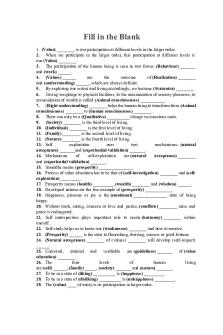
Question Bank 3question bank
- 6 Pages

Question BANK
- 19 Pages

MC test bank - comm 205 test bank
- 116 Pages
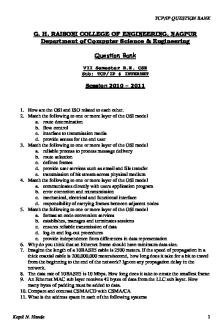
Tcp-ip-question-bank
- 25 Pages

Chapter 4 - Question Bank
- 28 Pages

DIP Question Bank Sheetal
- 14 Pages
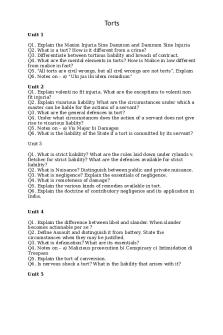
Torts Question Bank
- 2 Pages
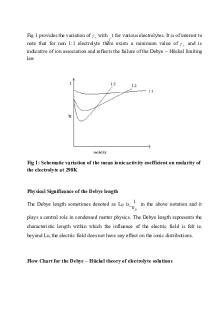
QB5 - Question Bank 5
- 104 Pages

Assessment Question Bank 1
- 22 Pages
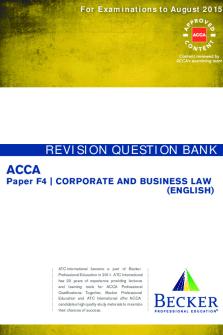
Revision Question Bank 60
- 154 Pages
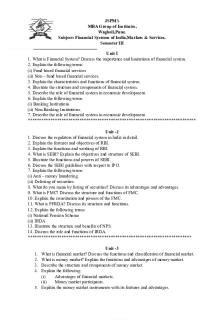
Fsims Question Bank
- 4 Pages

11. Autocad question bank
- 14 Pages
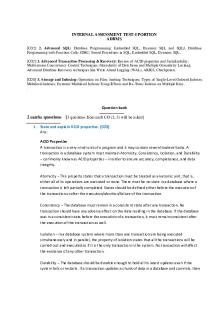
Question bank Adbms - solution
- 45 Pages
Popular Institutions
- Tinajero National High School - Annex
- Politeknik Caltex Riau
- Yokohama City University
- SGT University
- University of Al-Qadisiyah
- Divine Word College of Vigan
- Techniek College Rotterdam
- Universidade de Santiago
- Universiti Teknologi MARA Cawangan Johor Kampus Pasir Gudang
- Poltekkes Kemenkes Yogyakarta
- Baguio City National High School
- Colegio san marcos
- preparatoria uno
- Centro de Bachillerato Tecnológico Industrial y de Servicios No. 107
- Dalian Maritime University
- Quang Trung Secondary School
- Colegio Tecnológico en Informática
- Corporación Regional de Educación Superior
- Grupo CEDVA
- Dar Al Uloom University
- Centro de Estudios Preuniversitarios de la Universidad Nacional de Ingeniería
- 上智大学
- Aakash International School, Nuna Majara
- San Felipe Neri Catholic School
- Kang Chiao International School - New Taipei City
- Misamis Occidental National High School
- Institución Educativa Escuela Normal Juan Ladrilleros
- Kolehiyo ng Pantukan
- Batanes State College
- Instituto Continental
- Sekolah Menengah Kejuruan Kesehatan Kaltara (Tarakan)
- Colegio de La Inmaculada Concepcion - Cebu